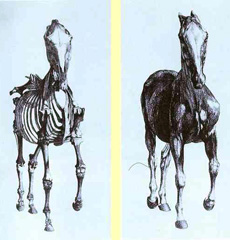

Motion is the element of the horse... Gustav Steinbrecht |
Morphology |
| Back to INFORMATION |
Conformational Characteristics of the Breed (information from ANCCE) |
| Head | Neck | Trunk | Back | Croup | Loin | Forehand | Hindquarters | Movement | Temperament | Ministerial | General |
| Head |
The official definition describes it as "an average sized head, which is rectangular, fine, with a straight or slightly concave profile; mobile ears of a medium size, well placed and parallel; a forehead wide, flat or slightly convex, big bright triangular eyes with an expressive look". |
Of average length and size, lightly arched and muscular (less so, in mares). Well inserted at the head and body. Abundant silky mane. |
| Trunk |
Proportionate and robust. The withers unobtrusively wide and obvious. Solid and muscular back. Wide, short loin, muscular and somewhat rounded, well joined to the back and the croup. |
| Back |
Located between kidneys and the withers, this is where the impulsion created by the hindquarters is transmitted to the forehand. It should be flexible, fairly short and sufficiently wide in proportion to the rest of the animal's body, and it should be very slightly concave. |
This should be of average length and width, rounded and lightly sloping. The tail should be low-set and placed between the two buttocks; it should consist of abundant, long and often wavy hair. |
This is formed by the six lumbar vertebrae, and the muscular mass that covers them, between the back and the croup. The Lumbar region of the PRE is short, rather wide and very sensitive to the touch. |
A long muscular, sloping and elastic shoulder. Strong humerus with a good inclination. Potent forearm, of average length. Well developed and lean knee. |
Well muscled thigh, lightly rounded and muscular buttock and long leg. Strong, wide and clean hock. |
Agile, high, extensive, harmonic and rhythmic. With a particular predisposition for collection and turns on the haunches. To complement all these conformational characteristics, the thing most outstanding about this breed is its versatility. This is due to the union of the following factors: mental balance, harmony, intelligence and will to work. |
| Temperament |
The PRE is a well balanced and resistant horse. Long-suffering and energetic, noble and docile, which adapts itself with ease to diverse uses and situations. It is very responsive to the rider's aids and has a good mouth, and therefore is obedient, with an easy understanding between it and the rider and is extraordinarily comfortable. |
Spanish Ministerial Order 25418 APA/3319/December 31, 2002; Article 3 describes the Racial Prototype of the Pura Raza Espanola, and has been paraphrased below. The head is well proportioned, of medium length and is thin, with a slightly convex or flat profile. The forehead is slightly wide and somewhat rounded. The eyes should be generous, lively and triangular shaped, with an expressive gaze; the orbital arches should not protrude from the profile. The ears are of average size and should be very mobile. The nostrils are almond shaped, not protruding, and the jaw is full and lean flowing into a long, discreetly arched jaw line. The neck is long and powerful, lightly arched, and set deep into a broad chest. Covering the neck is a silky and abundant mane. The withers are high, flowing in a smooth prolongation into the back. The torso is well proportioned and robust, with a short-coupled body and powerful hind quarters, ending in a low set tail, with thick and often wavy hair. Their feet are hard and tough and their hair is fine and short. Grey and bay are the dominant colours, but other colours (such as black and chestnut) are acceptable. Spanish Ministerial Order 25418 APA/3319/December 31, 2002 (Spanish version only). |
| General |
We have been informed on several occasions that the heels of the P.R.E. are often slightly higher than those of other breeds, and should not be 'dropped too much'. In our opinion, the PRE's temperament is brave, calm, sensible and honest, with a gift for learning and an aptitude for performing diverse functions willingly and kindly. According to Juan Carlos Altamirano, a Spanish horse historian, in the 18th Century, approximately 73% of the horses in the Spanish Stud Books were grey, with the rest being predominantly black and bay. The fashion for black horses declined over the next century, possibly due to the fact that black horses were traditionally used in funeral processions. The Royal Stud apparently maintained a preference for grey horses until the 'French invasion' when bay became more fashionable than grey. In 1928, only 19% of the horses in the stud book were grey. Today, approximately 70% of the P.R.E. horses in Spain are grey, with the rest being Bay and Black. In 2002, the stud book allowed all solid coloured horses to be included on the register, allowing chestnut horses to be included. |
|